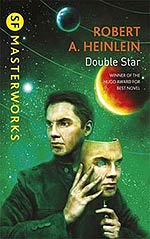
![]() Naomi_uk72
Naomi_uk72
3/26/2020
![]()
Double Star was first serialised in the pages of Astounding Science Fiction, appearing in three instalments in the February, March and April 1956 issues (July, August and September in the UK). In the same year it also appeared in hardback, published by Doubleday in the US.
It tells, in first person, the tale of Lawrence Smith, aka The Great Lorenzo, a down-and-out actor on his last coin when he is approached by a spaceman in a bar and offered a job impersonating a known public figure. Quickly finding himself drawn into an interplanetary conflict, it's only once he's on his way to Mars that he learns the man he's going to impersonate is none other than John Joseph Bonforte, one of the most prominent politicians in the solar system. Bonforte has been kidnapped by his political rivals, and it falls to Smith to take Bonforte's place in an important Martian ceremony.
Despite his opposition to Bonforte's political views, Smith begrudgingly agrees to take on the role. As he studies recordings of Bonforte's appearances and learns more about the man he is impersonating he gradually grows to like him, perhaps even admire him. When Bonforte is finally rescued and it's revealed that he is medically incapable of returning to public service, Smith is convinced to continue in the role, taking on the mantle of Supreme Minister in Bonforte's place.
Setting aside his own anti-Martian prejudice, Smith is called upon to assume Bonforte's views and fight for voting rights for the Martian people. When the governing party unexpectedly announces its intention to step aside Smith is forced to stand in an election, a task that requires that he call upon every ounce of his craft.
The Review
It's hardly surprising this book won the Hugo for Best Novel in 1956. It is arguably one of Heinlein's finest works, and certainly one of his best first-person narratives. The character of Lawrence Smith is fully realised, with a strong sense of identity and Independence that eludes many of Heinlein's other first-person characters. What's more, that sense of identity slowly morphs throughout the story as Smith begins to take on the persona of Bonforte. This gives Heinlein a chance to question what makes a man, what identity is in the first place, and he does a masterful job of presenting his findings here.
The trope of a double taking on the identity of a person of importance is an old one, and includes works by Mark Twain (The Prince and the Pauper) and Anthony Hope (The Prisoner of Zenda) being two examples. Even so, Heinlein manages to take something familiar and give it a new spin, a surprising freshness. While the outcome is almost predictable, it's the way he tells the story that keeps us reading. This is Heinlein showing us just how good he can be when he wants to be.
Conclusion
While there are a few elements in this book that are truly dated to a modern reader, most notably the Martian race, the core themes of Double Star are still relevant today. This is a story that resonates regardless of where or when you read it, and it's almost a certainty that if it were released today it would be in with a good chance of making the Hugos shortlist. It's not hard to understand why this book has stayed in print since its original release; in 2012 it was included in the Library of America's two-volume set American Science Fiction: Nine Classic Novels of the 1950s, and in 2013 it was added to Gollancz' SF Masterworks series.
Heinlein went on to win three more Best Novel Hugos during his lifetime, along with more than a few Retro Hugos in more recent years. Even so, in my opinion this is still one of his best books and easily deserves four-and-a-half out of five stars. It truly is one of the classics of 50's science fiction, and an excellent place to start if you've not previously read any of Heinlein's work.